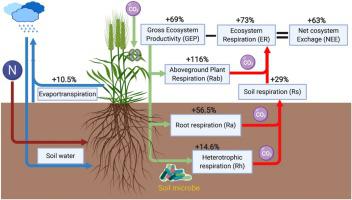当前位置:
X-MOL 学术
›
Agric. Ecosyst. Environ.
›
论文详情
Our official English website, www.x-mol.net, welcomes your feedback! (Note: you will need to create a separate account there.)
Asymmetric response of ecosystem carbon components and soil water consumption to nitrogen fertilization in farmland
Agriculture, Ecosystems & Environment ( IF 6.6 ) Pub Date : 2021-01-01 , DOI: 10.1016/j.agee.2020.107166 Weiming Yan , Yangquanwei Zhong , Wenzhao Liu , Zhouping Shangguan
Agriculture, Ecosystems & Environment ( IF 6.6 ) Pub Date : 2021-01-01 , DOI: 10.1016/j.agee.2020.107166 Weiming Yan , Yangquanwei Zhong , Wenzhao Liu , Zhouping Shangguan

|
Abstract Farmlands receive large amounts of nitrogen (N) through fertilization, which can affect ecosystem carbon (C) and water fluxes. However, the responses of ecosystem C components to N fertilization and their relationships with soil water consumption under N fertilization remain unclear. In the present study, we investigated the ecosystem C components and evapotranspiration under three N fertilizer rates application (0, 180 and 360 kg N ha−1 year−1, referred to as N0, N180 and N360, respectively) of two wheat varieties in three continuous growing seasons. We found that N fertilization increased all ecosystem C components as well as evapotranspiration. Excessive N application rates (N360) did not increase the net ecosystem C exchange (NEE) compared with that in the N180 treatment, which was mainly due to the larger increase in aboveground plant respiration (Rab) in the N360 treatment than the N180 treatment. The effects of N fertilization on NEE were larger than the effects on evapotranspiration, which led to an increase in water use efficiency (WUE). In addition, N fertilization increased soil respiration (Rs) by promoting both heterotrophic respiration (Rh) and root respiration (Ra), but a threshold effect of the N application rate on the Rs components was observed. Furthermore, the ecosystem C components showed different sensitivities to N fertilization, with Rab showing the highest sensitivity. Moreover, the changes in the C components were affected by the growing season and varieties, and mainly driven by biomass rather than by soil temperature or evapotranspiration. Our results demonstrate that N fertilization promoted ecosystem C fluxes, but that excessive N did not enhance the C fixation rate of the agroecosystem. These findings can inform global C-cycling models aimed at predicting C balances under N fertilization.
中文翻译:

生态系统碳成分和土壤水分消耗对农田施氮的不对称响应
摘要 农田通过施肥获得大量的氮(N),这会影响生态系统的碳(C)和水通量。然而,生态系统C组分对施氮的响应及其与施氮条件下土壤水分消耗的关系尚不清楚。在本研究中,我们调查了两种小麦品种在三种施氮量(0、180 和 360 kg N ha−1 年−1,分别称为 N0、N180 和 N360)下的生态系统碳成分和蒸散量。三个连续的生长季节。我们发现施氮增加了所有生态系统碳成分以及蒸散量。与 N180 处理相比,过量施氮(N360)并未增加净生态系统碳交换(NEE),这主要是由于与 N180 处理相比,N360 处理中地上植物呼吸 (Rab) 的增加更大。施氮对NEE的影响大于对蒸散的影响,从而导致水分利用效率(WUE)的增加。此外,施氮通过促进异养呼吸 (Rh) 和根呼吸 (Ra) 来增加土壤呼吸 (Rs),但观察到施氮量对 Rs 组分的阈值效应。此外,生态系统C组分对施氮的敏感性不同,其中Rab敏感性最高。此外,C成分的变化受生长季节和品种的影响,主要受生物量驱动,而不是受土壤温度或蒸发蒸腾作用。我们的结果表明施氮促进了生态系统的碳通量,但过量的氮并没有提高农业生态系统的碳固定率。这些发现可以为全球碳循环模型提供信息,旨在预测施氮下的碳平衡。
更新日期:2021-01-01
中文翻译:

生态系统碳成分和土壤水分消耗对农田施氮的不对称响应
摘要 农田通过施肥获得大量的氮(N),这会影响生态系统的碳(C)和水通量。然而,生态系统C组分对施氮的响应及其与施氮条件下土壤水分消耗的关系尚不清楚。在本研究中,我们调查了两种小麦品种在三种施氮量(0、180 和 360 kg N ha−1 年−1,分别称为 N0、N180 和 N360)下的生态系统碳成分和蒸散量。三个连续的生长季节。我们发现施氮增加了所有生态系统碳成分以及蒸散量。与 N180 处理相比,过量施氮(N360)并未增加净生态系统碳交换(NEE),这主要是由于与 N180 处理相比,N360 处理中地上植物呼吸 (Rab) 的增加更大。施氮对NEE的影响大于对蒸散的影响,从而导致水分利用效率(WUE)的增加。此外,施氮通过促进异养呼吸 (Rh) 和根呼吸 (Ra) 来增加土壤呼吸 (Rs),但观察到施氮量对 Rs 组分的阈值效应。此外,生态系统C组分对施氮的敏感性不同,其中Rab敏感性最高。此外,C成分的变化受生长季节和品种的影响,主要受生物量驱动,而不是受土壤温度或蒸发蒸腾作用。我们的结果表明施氮促进了生态系统的碳通量,但过量的氮并没有提高农业生态系统的碳固定率。这些发现可以为全球碳循环模型提供信息,旨在预测施氮下的碳平衡。


























 京公网安备 11010802027423号
京公网安备 11010802027423号